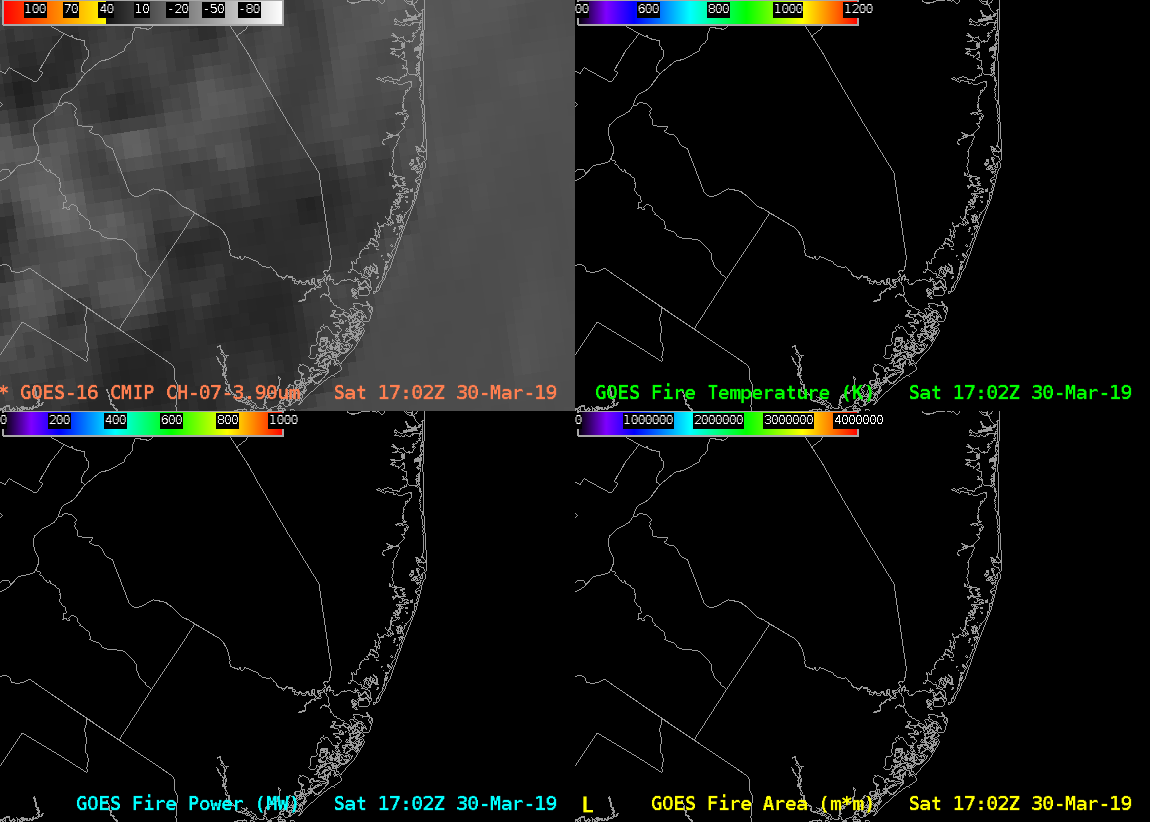Spring Hill Fire in New Jersey
GOES-16 Near-Infrared “Snow/Ice” (1.61 µm, left), Near-Infrared “Cloud Particle Size” (2.24 µm, center) and Shortwave Infrared (3.9 µm, right) images [click to play animation | MP4]
GOES-16 also initially viewed this area with 1-minute imagery from 1700-1859 UTC (since the Mesoscale Sector #1 normally covers New Jersey), and first displayed a fire hot spot around 1745 UTC. The animation below shows Visible imagery (0.64 µm), with Shortwave Infrared imagery in the background. One-minute data was valuable during these two hours because the rapidly moving clouds occasionally allowed brief views of the surface. It’s also easier to identify the smoke plume as a coherent structure with a 1-minute cadence (vs. the 5-minute cadence available with CONUS scans). At 1900 UTC, GOES-16 Mesoscale Sector #1 was repositioned to cover developing convection over the mid-Mississippi River Valley, so 1-minute views of New Jersey were terminated.

GOES-16 “Red” Visible (0.64 µm) imagery, with Shortwave Infrared (3.9 µm) pixels displayed through the semi-transparent visible images [click to play animation | MP4]

GOES-16 Shortwave Infrared (3.9 µm, upper left), GOES Fire Temperature (upper right), GOES Fire Area (lower right) and GOES Fire Power (lower left) [click to play animation | MP4]
![Suomi NPP VIIRS Near-Infrared (1.61 µm and 2.24 µm), Shortwave Infrared (3.74 µm) and Day/Night Band (0.7 µm) images [click to enlarge]](https://cimss.ssec.wisc.edu/satellite-blog/wp-content/uploads/sites/5/2019/03/190331_0703utc_suomiNPP_nearInfrared_shortwaveInfrared_dayNightBand_Spring_Hill_Fire_NJ_anim.gif)
Suomi NPP VIIRS Near-Infrared (1.61 µm and 2.24 µm), Shortwave Infrared (3.74 µm) and Day/Night Band (0.7 µm) images [click to enlarge]
A little science on the night shift (thread)! We’ve gotten many questions about the smoke across central and northern NJ tonight. This smoke is originating from the Spring Hill Forest Fire in Penn State Forest in Burlington County. #njwx pic.twitter.com/OW8GmTS1Ii
— NWS Mount Holly (@NWS_MountHolly) March 31, 2019
===== 01 April Update =====
In a comparison of Terra MODIS True Color and False Color RGB images on 01 April from the MODIS Today site (above) the fire burn scar was evident in the False Color image.The appearance of the burn scar was also seen in a before/after toggle between Terra MODIS False Color RGB images on 27 March and 01 April (below).
A closer view of the 01 April Terra MODIS False Color RGB image using RealEarth (below) showed that the northeastern edge of the burn scar was near Route 72 (which had to be closed as the fire was being contained), and may have threatened structures at Coyle Field.===== 08 April Update =====
A 30-meter resolution Landsat-8 False Color RGB image from 08 April (above) provided a very detailed view of the Spring Hill Fire burn scar. It suggested that the fire did cross Route 72 at Coyle Field.

![NOAA-20 and Suomi NPP VIIRS Shortwave Infrared (3.74 µm) images [click to enlarge]](https://cimss.ssec.wisc.edu/satellite-blog/wp-content/uploads/sites/5/2019/03/190330_190331_viirs_shortwaveInfrared_Spring_Hill_Fire_NJ_anim.gif)
![Terra MODIS True Color and False Color images on 01 April [cick to enlarge]](https://cimss.ssec.wisc.edu/satellite-blog/wp-content/uploads/sites/5/2019/03/190401_terra_modis_truecolor_falsecolor_Spring_Hill_Fire_NJ_burn_scar_anim.gif)
![Terra MODIS False Color RGB images on 28 March and 01 April [click to enlarge]](https://cimss.ssec.wisc.edu/satellite-blog/wp-content/uploads/sites/5/2019/03/190327_190401_terra_modis_falsecolor_Spring_Hill_Fire_NJ_burn_scar_anim.gif)
![Terra MODIS False Color RGB and Google Maps background images [click to enlarge]](https://cimss.ssec.wisc.edu/satellite-blog/wp-content/uploads/sites/5/2019/03/190401_1625utc_terra_modis_falsecolor_NJ_anim.gif)
![Landsat-8 False Color RGB image, with Google Maps background [click to enlarge]](https://cimss.ssec.wisc.edu/satellite-blog/wp-content/uploads/sites/5/2019/04/190408_1534utc_landsat8_falsecolor_Spring_Hill_Fire_NJ_burn_scar_anim.gif)